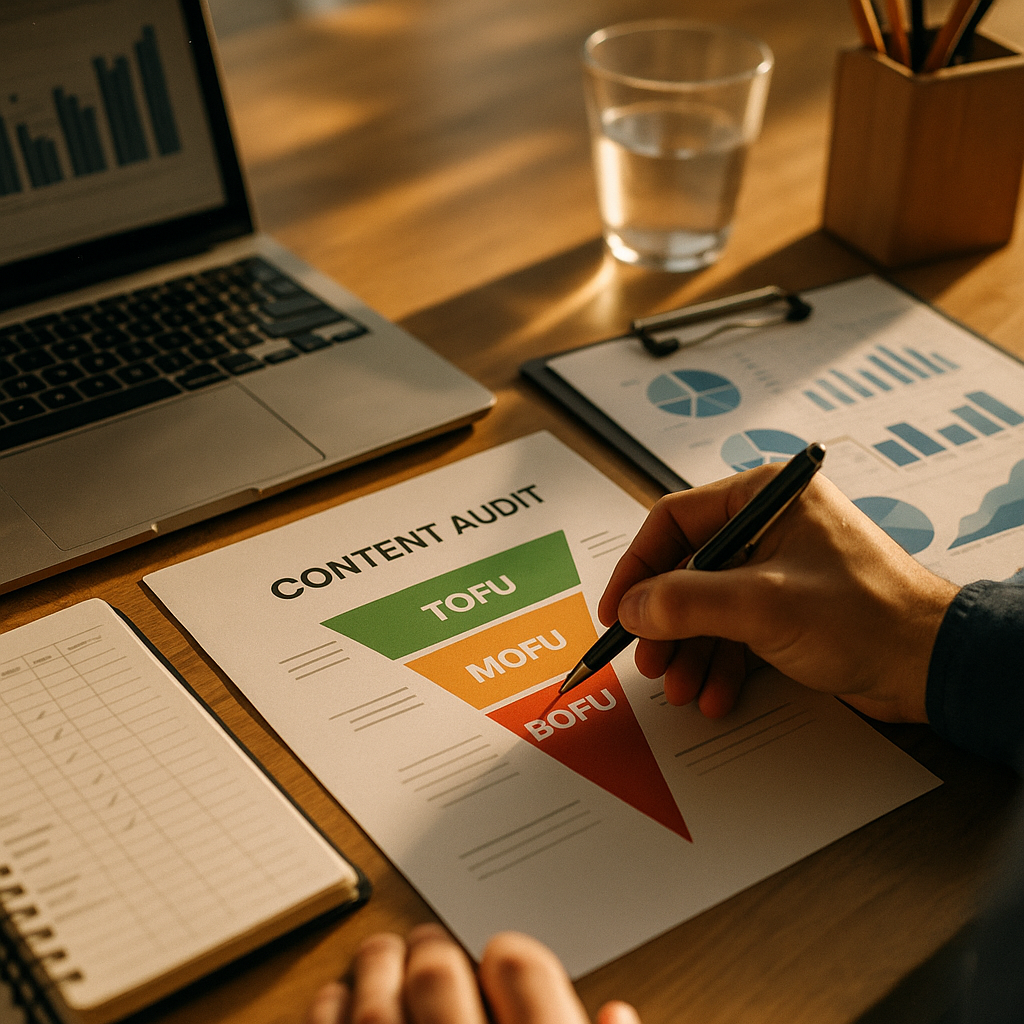Performing a full-funnel content audit is essential for brands aiming to maximize their digital impact and drive measurable growth. By reviewing your assets through every funnel stage, you can spot strategic gaps and boost conversions. Ready to supercharge your content’s performance? Discover a proven framework that turns auditing into growth opportunities.
Understanding the Full-Funnel Approach in Content Auditing
To conduct an effective content audit, you need to grasp the “full-funnel” concept. The marketing funnel encompasses all stages of buyer engagement—from generating awareness at the top to nurturing leads and closing sales at the bottom. Assessing content with this holistic view ensures you meet audience needs at every step, leading to increased trust, conversions, and loyalty. According to HubSpot’s 2025 survey, 74% of marketers now map content to specific buyer journey stages to improve ROI. This approach aligns your audit with strategic business outcomes.
Preparatory Steps: Setting Objectives and Collating Content Assets
Before diving in, clarify your audit’s objectives. Are you seeking to fill content gaps, repurpose top-performing pieces, or improve SEO? Defining goals sharpens your focus and informs your audit criteria. Next, assemble an inventory of all relevant content assets—blogs, landing pages, videos, eBooks, emails, and social media posts. Use a content inventory template or automated tools like Screaming Frog or SEMrush Content Audit, ensuring all assets are cataloged by type, funnel stage, and target audience. This preparation lays a robust foundation for analysis.
Mapping Content to the Customer Journey for Targeted Gaps
Mapping existing assets to the customer journey is a critical secondary keyword strategy for your SEO-fueled audit. Classify each piece by funnel stage: Awareness (top), Consideration (middle), and Decision (bottom). Ask:
- Does every persona have content at each funnel layer?
- Are high-intent search queries matched by relevant pieces?
Noting overlaps or shortages shows where prospects might disengage or where you’re missing conversion opportunities. Industry leaders report that companies with documented funnel mapping increase conversion rates by up to 53% (Content Marketing Institute, 2025). Use this insight to inform content creation priorities and refine your customer experience.
Evaluating Content Performance with Data-Driven Metrics
Armed with an organized content map, delve into performance analytics. Use tools such as Google Analytics 4, Search Console, and social listening platforms. Key metrics to evaluate include:
- Traffic and page views: Reveal reach at the awareness stage.
- Engagement metrics (average time on page, bounce rate): Indicate value during consideration.
- Conversion rates and assisted conversions: Highlight impact at the decision stage.
- Backlink profiles and keyword rankings: Assess organic authority and SEO strength.
Benchmark each asset against its intended funnel stage to identify underperformers, top contributors, and pieces needing optimization. As of 2025, data-driven audits speed up content value realization by up to 31% (Semrush State of Content Marketing Report).
Aligning Content with EEAT: Expertise, Experience, Authority, and Trust
Google’s advanced 2025 algorithms prioritize content built on EEAT principles. To earn better rankings and audience trust, evaluate each piece for:
- Expertise: Is the information accurate, well-sourced, and written by qualified authors?
- Experience: Does the content demonstrate hands-on use or industry knowledge?
- Authority: Are authors and sources recognized in the niche?
- Trust: Is data cited from recent, verifiable sources, and are transparency signals (such as author bios and updated dates) visible?
Enhance weak content by supplementing with expert insights, recent statistics, and proper attribution. Boost trust elements through transparent disclosure, reviews, and robust editorial standards—especially for YMYL (Your Money or Your Life) topics. This increases both user confidence and search visibility.
Action Plan: Optimizing, Repurposing, and Filling Gaps
With insights from your full-funnel content audit, build a strategic action plan. Sort recommendations by impact and effort, then categorize content into:
- Keep: Top performers aligned with funnel stages—consider minor updates only.
- Optimize: Assets with solid potential but in need of SEO or EEAT improvements (e.g., better headings, internal links, updated data).
- Repurpose: High-engagement pieces that can be adapted for new formats or channels to support additional funnel stages.
- Retire or Merge: Outdated, duplicate, or low-performing content bogging down site authority.
- Create: New assets to fill critical funnel gaps, informed by your initial mapping and competitor analysis.
Schedule changes using a visual content calendar. Emphasize quick wins to drive results while planning bigger overhauls for consistent growth.
FAQs: Full-Funnel Content Audit
-
Why is a full-funnel content audit important?
It ensures your content strategy supports every stage of your customer journey, increasing conversions and user satisfaction. Identifying gaps and optimizing key assets amplifies ROI. -
How often should I conduct a content audit?
Ideally, perform a full-funnel audit twice a year. However, adjust the frequency based on content volume, industry changes, and marketing goals. -
What tools can help with full-funnel content auditing?
Popular options include Google Analytics 4, SEMrush, Ahrefs, Screaming Frog, and content inventory spreadsheets tailored to track funnel positions and performance. -
What’s the main difference between a standard and a full-funnel content audit?
A standard audit reviews content for quality and performance. A full-funnel audit assesses content’s strategic alignment with every stage of the buyer’s journey, driving more targeted outcomes.
In 2025, a full-funnel content audit is no longer optional—it’s an engine for strategic growth. By combining EEAT best practices, data-backed decisions, and content mapping, you’ll boost engagement and conversions across your customer journey. Make auditing an ongoing pillar of your digital marketing to stay ahead.
